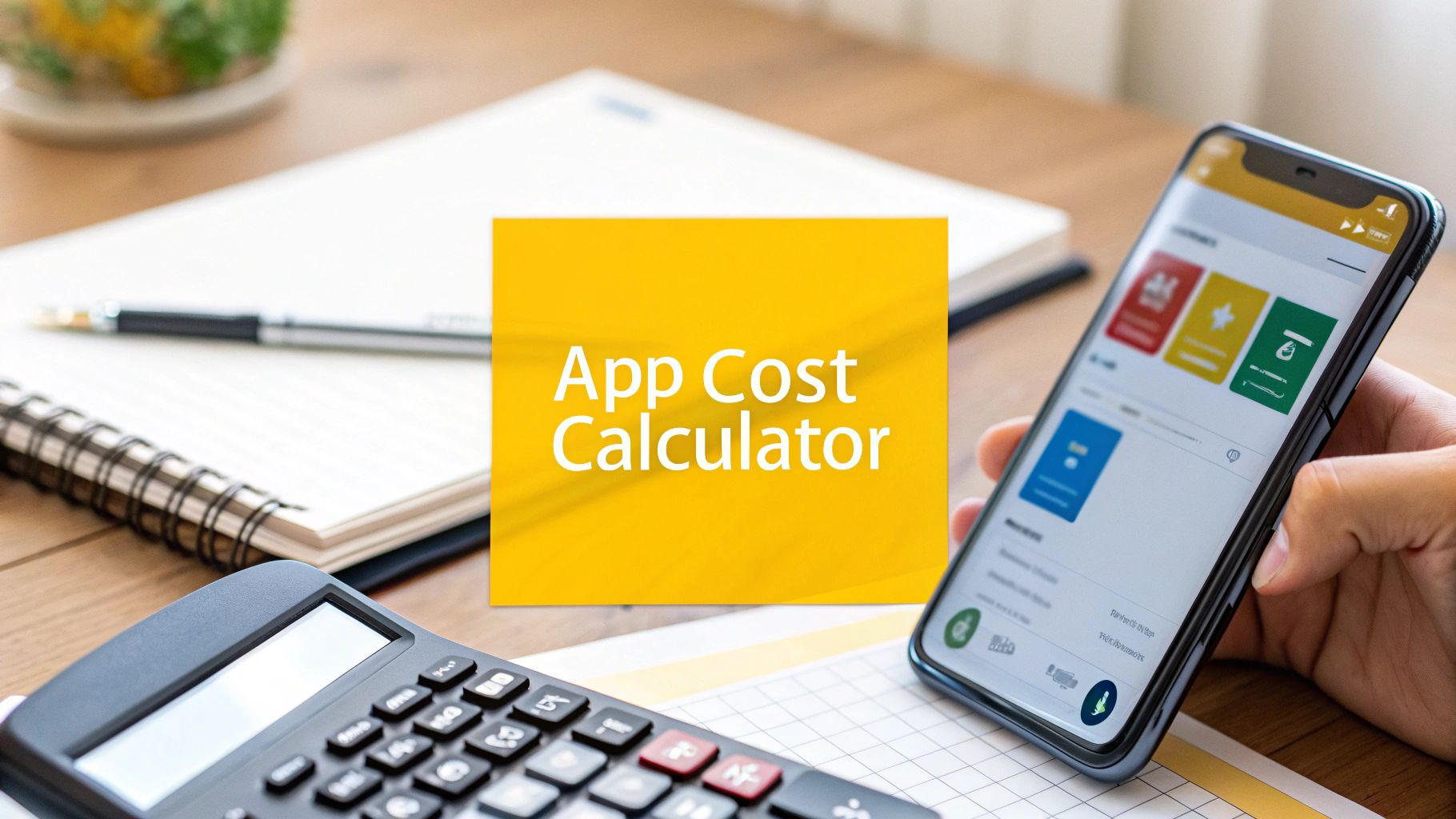Your Mobile App Development Cost Calculator Guide

At its core, a mobile app development cost calculator isn't some black box—it relies on a surprisingly simple formula: (Total Development Hours) x (Developer Hourly Rate) = Total Cost. This is the backbone of every app budget you'll ever see, whether for a basic utility or a massive social media platform. Getting a handle on this equation is the first real step toward building a sensible financial plan.
The Simple Math Behind Your App Development Cost

Before you get lost in complex spreadsheets and online estimators, it's crucial to understand the fundamental math that will shape your final quote. Every single feature, screen, and third-party connection you dream up translates directly into hours of work for a development team. This is the variable that will have the biggest impact on your budget.
For example, an app that tallies up to 2,500 development hours with a team charging a blended rate of $40 per hour will land you at a $100,000 price tag—and that’s before you even think about post-launch maintenance. This quick calculation makes it obvious why having a detailed feature list is an absolute must-have for getting an accurate estimate.
Creating A Back-Of-The-Napkin Estimate
You don't need to be a coding guru to sketch out a rough budget. The trick is to break down your big idea into its major functional pieces. Don't get bogged down in the tiny details just yet; think in terms of the core building blocks.
A good starting point is to list out these components:
- User Accounts: Will people need to sign up, log in, or manage a personal profile?
- Core Functionality: What's the main thing your app does? Is it booking appointments, streaming videos, or connecting users?
- Admin Panel: How will you, the owner, manage everything behind the scenes—from users and content to app settings?
- Integrations: Does the app need to talk to other services like payment processors, mapping tools, or social media platforms?
Jotting down these high-level features gives you a solid foundation for a much more productive conversation with a development agency. It’s your first reality check on what’s feasible and helps everyone set clear expectations from the get-go. For a deeper dive into the total investment, you can consult a thorough guide on how much does app development cost.
For those who want a quick snapshot, here's how complexity generally translates into time and money.
Quick App Cost Estimation by Complexity
This table offers a bird's-eye view of potential costs and timelines based on the scope of your project. Use it as a starting point to align your expectations with your budget.
| App Complexity | Estimated Hours | Estimated Cost Range | Typical Timeline |
|---|---|---|---|
| Simple | 300 - 600 | $10,000 - $30,000 | 2 - 4 months |
| Medium | 600 - 1,200 | $30,000 - $80,000 | 4 - 8 months |
| Complex | 1,200 - 2,500+ | $80,000 - $250,000+ | 8+ months |
Remember, these are ballpark figures. The final numbers will always depend on the specifics of your feature set and the hourly rates of the team you choose.
Key Takeaway: The goal of your first estimate isn't to land on a perfect number. It's to understand the direct link between features, time, and money. Grasping this early on prevents sticker shock and empowers you to make smarter trade-offs during the crucial planning phase. To see how these factors play out in various real-world scenarios, check out our guide on the https://getnerdify.com/blog/average-cost-to-develop-an-app.
Turning App Features Into Development Hours
The real cost of your app comes down to its features. Every single button, screen, and user interaction adds to the development timeline. This is why having a detailed feature list is the single most important piece of the puzzle when you're trying to figure out your budget. You have to break your big idea down into smaller, tangible parts to get from a concept to a real number.
This isn't just about making a wish list. You have to think through the complexity behind each item. For example, "user login" sounds simple, right? But are we talking about a basic email and password? Or do you want to include one-click sign-ins with Google and Apple? Each of those social logins adds hours for integrating their specific APIs and testing them thoroughly. It's these kinds of details that explain why app development can cost anywhere from $10,000 to over $500,000.
Breaking Down Core App Functionality
Let's get practical and look at how common features translate into actual work hours. This isn't an exact science—every project is different—but it gives you a solid framework for a ballpark estimate.
- User Authentication (40-80 hours): A standard email and password setup is on the lower end. Once you start adding social logins, two-factor authentication, or "forgot password" workflows, you quickly climb toward the higher end of that range.
- Push Notifications (20-50 hours): Sending a simple alert to all users is relatively quick. But if you want to send notifications with images, add interactive buttons, or segment your audience based on their behavior, the work gets a lot more involved.
- Admin Panel (60-200+ hours): Need a basic dashboard just to see a list of users? That's fairly straightforward. But a full-blown control center for managing content, viewing analytics, moderating activity, and tweaking settings can easily become a project in its own right.
Seeing these ranges helps you make smarter decisions. Maybe a simple admin panel is all you need for your initial launch. You can always build out the fancy analytics in version two.
A feature is never just one thing. It’s a whole bundle of tasks: UI design, frontend development, backend logic, API work, and a ton of testing. That's why a feature that sounds "simple" can still take a full week or more to implement properly.
Estimating Complex and Custom Features
Once you move past the standard stuff, custom and advanced features need even closer attention. These are often the things that make your app unique, but they also represent the biggest slice of your budget.
Take in-app purchases, for instance. It's not just about plugging in a payment processor. You have to set up all your products on the App Store and Google Play, manage different transaction statuses (like pending, failed, or successful), and build a secure system for handling subscriptions or user credits. That feature alone can easily take 80-150 hours.
Here's a look at what to expect for other common complex features:
| Feature Type | Description | Estimated Hours |
|---|---|---|
| Social Integration | Letting users share content, import contacts from their phone, or see a social feed inside the app. | 50 - 100 hours |
| Real-Time Chat | Building a messaging system with DMs, group chats, photo sharing, and read receipts. | 90 - 200+ hours |
| Geolocation & Mapping | Using GPS to track a user's location, display things on a map, or help them find nearby places. | 60 - 160 hours |
Each of these requires specialized skills. Accurately guessing how long they'll take is an art, which is why leaning on proven software estimation techniques is so important for keeping your project on track and on budget. When you break your vision down feature by feature, you’re not just building a to-do list; you’re building a realistic roadmap and taking control of your spending.
How Developer Location Shapes Your Budget

One of the biggest factors that can make or break your app development budget is something surprisingly simple: geography. The developer's hourly rate is a critical variable in any cost calculation, and it swings wildly depending on where in the world your team is located.
It's a strange reality of the tech world, but the same line of code from a senior developer in San Francisco can cost five times more than if it were written by an equally skilled developer in Eastern Europe. This isn't about a difference in quality; it's purely about the economics of global talent markets.
Just look at the numbers. You could be paying $100 to $250 per hour for talent in North America, while rates in Eastern Europe hover between $35 and $70. That's a massive difference that offers a strategic advantage if you're open to outsourcing.
Understanding Regional Rate Differences
When you start looking for talent, the world is your oyster. But where you decide to drop your anchor has a huge impact on the final bill. Digging into guides on offshore development centers can offer some great insights into leveraging global talent. But remember, cost isn't everything. You also have to think about practical things like time zone overlap, communication styles, and cultural fit.
Here’s a quick breakdown of what you can expect from different regions:
- North America (US & Canada): You get maximum time zone alignment if you're US-based, and communication is usually seamless. The catch? You'll be paying the highest hourly rates on the planet.
- Western Europe (UK & Germany): This region boasts a massive pool of highly skilled developers with excellent English. Rates are a bit friendlier than in North America, but still on the premium side.
- Eastern Europe (Poland & Ukraine): For many, this is the sweet spot. You get access to incredible technical skill and a strong work ethic, all at much more competitive rates.
- Asia (India & Philippines): This is where you'll find the lowest hourly rates, which is incredibly tempting for projects on a tight budget. However, be prepared for more hands-on management to navigate significant time zone and cultural differences.
The table below breaks down these regional differences, giving you a clearer picture of what to expect when you're budgeting.
Average Developer Hourly Rates by Region
| Region | Average Hourly Rate (USD) | Pros | Cons |
|---|---|---|---|
| North America | $100 - $250 | Same time zone, easy communication, strong legal framework. | Highest cost globally, highly competitive talent market. |
| Western Europe | $80 - $180 | Large talent pool, high skill level, good English proficiency. | High rates, complex regulations in some countries (e.g., GDPR). |
| Eastern Europe | $35 - $70 | Excellent value, strong technical education, good work ethic. | Some time zone differences, potential for minor cultural gaps. |
| Asia | $25 - $50 | Lowest cost, large and rapidly growing talent pool. | Significant time zone and cultural differences, requires more management. |
As you can see, the financial implications are significant. Choosing a team from a more affordable region can stretch your budget much further, potentially allowing you to add more features or invest more in marketing.
Choosing the Right Engagement Model
Beyond where your developers are, you also need to decide how you'll work with them. This choice shapes your budget, your level of control, and the amount of management overhead you'll have to deal with.
Pro Tip: Your engagement model is about more than just money. It directly dictates how much control you have, how fast you can move, and how much of the project management load falls on your shoulders.
Let's walk through the three main ways to build your team.
- Hiring an In-House Team: This model gives you the most control and ensures your team is deeply integrated into your company culture. It's also, by far, the most expensive path. You're on the hook for salaries, benefits, office space, and long, often frustrating, recruitment cycles.
- Partnering with an Agency: Agencies are an all-in-one solution. You get developers, designers, project managers, and QA testers bundled together. This structure and expertise are fantastic, but you're paying a premium for that convenience.
- Assembling a Team of Freelancers: This can be the leanest, most cost-effective approach. You can hand-pick specialists for very specific tasks. The major downside? You become the project manager, responsible for coordinating everyone's work, ensuring quality, and keeping the project on track.
So, which is best? It all comes down to your budget, timeline, and how much you want to manage yourself. For many startups and small businesses, finding a balance is key. Options like nearshore software development can be a great middle ground, giving you cost savings with better time zone alignment than a fully offshore team.
Choosing a Platform That Fits Your Budget

One of the first, and most significant, decisions you'll make is where your app will live. Are you targeting iPhone users exclusively? Going all-in on Android? Or do you need to be on both platforms from day one? This isn't just a question of user reach; it sends huge ripples through your budget and timeline.
The platform dictates the programming languages, the specific skills your developers need, and the total hours logged. Get this wrong, and you could either blow your budget or completely miss the very people you’re trying to reach.
Native Development: The Premium Choice
When you hear "native," think of it as building two completely separate, custom-tailored applications. You'll have one app for iOS, likely built with Swift, and a second one for Android, using languages like Kotlin. This route gives you unparalleled performance, a perfectly polished user experience, and unrestricted access to every feature on the device.
But that premium experience comes with a premium price tag. You're not just building one app; you're essentially funding two distinct development projects at the same time. That means two codebases to maintain, two sets of bugs to squash, and two development workflows to manage. For a complex app, this decision alone can be the difference between a $150,000 project and a $300,000 one.
Cross-Platform Development: The Budget-Friendly Alternative
For most founders, especially those launching a new product, cross-platform development is the go-to strategy. Using a framework like React Native or Flutter, your team can write one primary codebase that works beautifully on both iOS and Android devices.
This shared codebase is an absolute game-changer for your budget. By building one app instead of two, you can slash development costs by as much as 30-40% compared to going native. It’s the most efficient way to get your app into both the Apple App Store and Google Play Store quickly. While you might see some slight performance trade-offs in highly graphic-intensive games, for the vast majority of business apps, the user experience is virtually identical to a native one.
Key Insight: Choosing cross-platform isn't about compromising on quality. It's a smart, strategic decision about how to best use your resources. It helps you launch faster and more affordably—a perfect fit for most MVPs and startups.
Web Apps: A Niche but Viable Option
Don't forget about the web app, often built as a Progressive Web App (PWA). Think of it as a website that’s been optimized to look and behave just like a native mobile app. It runs in a browser, which means anyone can access it on any device without a trip to the app store.
The initial development is usually much cheaper. The trade-off? Web apps have their limits. They can't always tap into a phone's advanced hardware (like certain camera functions or biometrics) and miss out on the visibility and user loyalty that comes from having an icon on a user's home screen.
To make it easier, here’s how they stack up:
| Platform Type | Best For | Typical Cost | Key Benefit |
|---|---|---|---|
| Native (iOS & Android) | High-performance apps needing full hardware access. | High | Unmatched performance and UX. |
| Cross-Platform | Most startups and businesses needing broad market reach. | Medium | Cost-effective for dual-platform launch. |
| Web App (PWA) | Simple tools or content-focused apps. | Low | No app store fees; universal access. |
Ultimately, this is a foundational decision. By carefully weighing your app's performance needs against the reality of your budget, you can make a choice that sets your project up for success from the very beginning.
Thinking Beyond Launch Day: The Real Costs of Running an App
Hitting "publish" on the app stores isn't the finish line. Honestly, it's not even close. It's the starting gun for a whole new set of financial commitments that many first-time founders completely miss. They get so laser-focused on the upfront build cost that they forget about what it takes to keep the app alive and kicking. That oversight can be a fatal flaw for a new business.
Here’s a solid rule of thumb I always share with clients: budget an extra 15-20% of your initial development cost annually just for maintenance. So, if you spent $100,000 on the initial build, you need to have $15,000 to $20,000 set aside every single year just to keep the lights on. We're not even talking about adding cool new features yet—this is purely for essential upkeep.
What Does "Maintenance" Actually Pay For?
So where does that 15-20% go? It’s not some arbitrary fee. It breaks down into a handful of absolutely critical tasks that keep your app functional, secure, and relevant.
Think of it this way. The money covers things like:
- Emergency Bug Squashing: No app is flawless. Users will always find creative ways to break things, and when they do, you need developers on hand to fix those bugs fast. Otherwise, you're looking at a flood of one-star reviews.
- Forced OS Updates: Every year, Apple and Google roll out major new versions of iOS and Android. If you don't update your app to stay compatible, it will start to glitch, crash, or worse, get booted from the app stores altogether.
- Server and Hosting Fees: All that user data has to live somewhere. You’ll be paying recurring fees for cloud services like AWS or Google Cloud, and these bills climb as more people start using your app.
- Performance Monitoring: You need tools to keep an eye on things like crash rates and load times. This is about spotting problems before they snowball and affect thousands of users.
I see this all the time: founders treat post-launch costs as an afterthought. You have to factor these ongoing expenses into your financial model from day one. They are just as critical as the initial design and coding.
The "Other" Costs You Can't Ignore
Beyond just keeping the app from breaking, there are other essential line items you need in your long-term budget. These are the costs tied to actually running your app as a business, not just a piece of technology.
Don't forget to account for these crucial areas:
- The App Store "Tax": Apple charges a $99 annual developer fee, while Google has a one-time $25 fee. The big one, though, is their commission—they take a 15-30% cut of every dollar you make from in-app purchases and subscriptions.
- Analytics and Marketing Tools: To make smart decisions, you need data. That means paying for subscriptions to services like Mixpanel to understand user behavior or other platforms for marketing automation.
- Getting People to Actually Download It: Unless you strike viral gold, you're going to have to spend money to acquire users. This means a real marketing budget for things like social media ads, paying influencers, or creating content to draw people in.
Frequently Asked Questions About App Costs

Even after mapping everything out, the financial side of app development can still feel a bit foggy. Let's clear the air and tackle some of the most common questions I hear from founders when they're trying to nail down their budget.
Getting these answers straight is crucial. It helps you set realistic expectations and sidestep the financial traps that can sink a project before it even launches.
How Accurate Is a Mobile App Development Cost Calculator?
Think of an online calculator as a great tool for a ballpark estimate, but not the final word. It's perfect for initial budgeting and getting a rough idea of what your MVP might run, but it’s no substitute for a formal, detailed proposal from a development team.
The accuracy of any calculator really boils down to the quality of your input. If you've thought through your features in detail, you'll get a much more realistic number back. At the end of the day, though, the final cost is locked in by the signed project scope and the specific hourly rates of the team you bring on board.
Can Building an MVP Really Save Me Money?
Without a doubt. Launching a Minimum Viable Product (MVP) is probably the single best strategy for managing your initial investment. It’s all about focusing on the absolute core features that solve a single, critical problem for your users. Everything else—all the nice-to-have extras—can wait for version two.
This laser-focused approach does a few things for you:
- It gets your app into the hands of real users much, much faster.
- You start gathering real-world feedback immediately, not just theories.
- It proves your core concept has legs before you sink a fortune into features nobody asked for.
Starting with an MVP can slash initial development costs by 50-60%. It’s simply the smarter, safer way for any new venture to get started.
The biggest budget-killer in app development is 'scope creep'. It's the slow, gradual addition of new features that weren't in the original plan. Every "small" tweak adds hours, and those hours stack up fast, inflating the final bill. An MVP-first mindset is your best defense against it.
Do I Need to Be a Technical Expert to Get an Accurate Estimate?
Not in the slightest. As a non-technical founder, you can get a very solid estimate by simply doing your homework. Your job isn't to be a coder; it's to communicate your vision with crystal clarity. A good development partner can take that vision and translate it into a technical roadmap.
So, how do you prepare? Focus on documenting your idea as thoroughly as you can.
- Write out user stories. Think from the user's perspective: "As a new user, I want to sign up with my Google account so I can get started in seconds."
- Sketch out simple wireframes. Grab a pen and paper or use a free tool to draw the main screens. It doesn't have to be pretty, just clear.
- Check out the competition. Look at similar apps to see what features are standard and what you can learn from them.
The more clarity you bring to the table about what you want to build, the more accurately a team can estimate the time and cost. It’s all about the strength of your vision, not your coding skills.